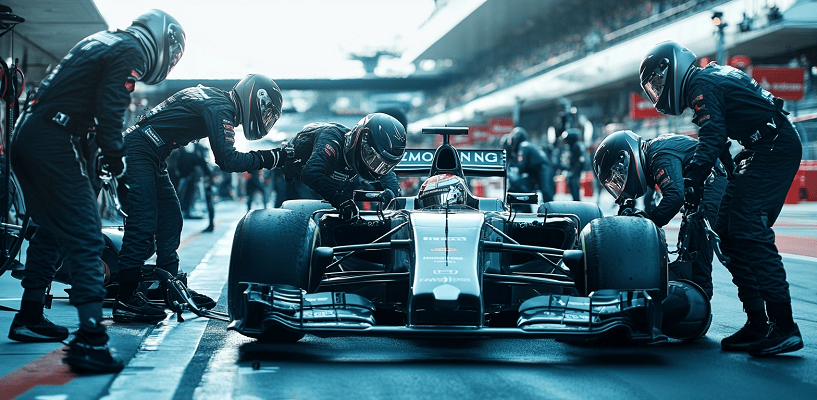Pit Lane

A pit lane is a designated area in motor racing tracks, typically running parallel to the main track, where race cars can pull off during a race for “servicing, refueling, repairs, tire changes, or driver changes.” Teams present in pit areas perform “repairs, tire changes, servicing, etc.”
Pit lanes are seen in many types of motorsports, including ‘Formula 1, NASCAR, MotoGP, and endurance racing,’ each with specific rules and layouts for pit operations.
Pit lane is sometimes informally referred to as ‘pit road or pit row,’ but the terminology varies depending on the ‘motorsport and region.’ Pit lane is the standard term used in “Formula 1, MotoGP, and many international racing series.” Pit road is commonly used in NASCAR and other American motorsports.
In motorsport, ‘reversing’ a car in the pit lane under its own power is strictly prohibited. This rule is implemented to ensure the safety of “drivers, pit crews, and officials” and to maintain the orderly flow of vehicles during the race.
The pit lane is separated into two lanes: the ‘inner lane’ is the lane nearest the garages/boxes, while “the ‘fast lane,’ which may be no wider than 3.5 meters and is the lane nearest the pit wall.” The ‘pit wall’ in motorsport is a designated area along the edge of the pit lane that separates the ‘pit lane’ from the racetrack. The ‘inner lane’ is the only place where an automobile can be worked on. No work may be carried out on a car in ‘fast lane,’ except under specific conditions where it does not make it difficult for other vehicles to exit the pit lane.
No portion of an automobile may be raised in the pit lane using a ‘motorized’ device.
In motorsport, a speed limit of 80 km/h (49.7 mph) is typically enforced in the ‘pit lane’ throughout the competition. The Race Director has the authority to modify the ‘speed limit’ based on recommendations from the Safety Delegate. Drivers exceeding the limit may face penalties, such as “time penalties, fines, or drive-through penalties.”
The length of a pit lane is not universally standardized and depends on various factors, including the “circuit design, safety regulations, and specific event requirements.” Examples of pit lane lengths: Monaco Grand Prix (~300 meters, shorter due to space constraints of the street circuit), Spa-Francorchamps (~700 meters, accommodates the “large track layout and garages”), Silverstone (~500 meters, medium length for a permanent circuit).
Sections of a Pit Lane -
Pit Entry -
The “pit entry” is the portion of the track between ‘the first safety car line’ (SC1) and the start of the pit lane. The ‘First Safety Car Line’ (SC1) is a marker that determines when certain actions, such as “overtaking the safety car or other competitors,” is permitted under specific conditions.
Pit entry is crucial as it ensures a ‘safe and controlled’ deceleration for vehicles entering the ‘pit lane.’
Pit Exit -
The “pit exit” is the portion of the track between ‘the second safety car line’ (SC2) and the end of the pit lane. The ‘Second Safety Car Line’ (SC2) is a marker that ensures cars exiting the pits rejoin the track in an orderly and safe manner, avoiding “collisions” or unsafe merges.
Pit exit is crucial for safe reintegration of cars onto the racing circuit.
Pit Box -
The ‘pit box’ is where pit stops take place during ‘sessions or the race.’ Individual space where the team performs tasks such as “tire changes, refueling, service, or repairs.” Each box is marked for the respective team.
Pit Lane Regulations -
- Cars are only allowed to be driven from the competitors’ assigned garage area to the end of the ‘pit lane,’ unless “at any point during the start process, they are pushed off from the grid.” The grid refers to the ‘marked’ section of the track where cars line up before the race.
- Unless another car is unnecessarily delayed, any “car or cars” that are driven to the end of the ‘pit lane’ before the ‘start or re-start’ of a practice session shall line up in the fast lane and depart in the order that they arrived.
- If a driver is mandated to start from the pit lane for a ‘sprint session or race,’ they cannot drive their car from their ‘designated garage area’ until the pit lane ‘exit’ is closed. Further, the driver must stop in line in the ‘fast lane’ of the pit lane after the pit lane ‘exit’ is officially closed before the scheduled start of the formation lap. Drivers must always heed the marshals’ instructions.
- Competitors are prohibited from painting ‘lines, markings, or any form of indication’ on the pit lane “floor, walls, or other surfaces.”
- When a car is in its ‘pit stop’ position during a ‘sprint session, qualifying practice session, or race pit stop,’ all team members are performing any maintenance on it in the pit lane. Only right before they are needed to work on a ‘car’ can team members enter the pit lane; they must leave as soon as the task is finished.
- Each driver is assigned a separate garage in the pit lane. However, each team is allocated only one ‘pit box’ in the pit lane, regardless of the number of “drivers or cars” they have. Thus, teams can only perform pit stop operations for ‘one’ car at a time in their designated pit box.
That’s all friends.
Suggestions or corrections for this page can be submitted from the “contact us” page.
Ads Section

